Conservation Assessment of the Stone Blocks in the Northeast Corner of the Karnak Temples in Luxor, Egypt
Abstract
1. Introduction
2. Architectural and Archaeological Context of the Case Study
3. Geographical and Geological Context
4. Quarries of Stone Blocks and Mineralogical Characterization
5. Hydrological and Climatological Context
6. Archaeoseismic and Flooding Hazard
7. Methodology
8. Results and Discussion
8.1. In Situ Assessment and Stone Decay
8.2. Stone Decay, Alteration, and Water Infiltration
8.3. Vegetation Change Detection
9. Restoration and Conservation Plan for Sandstone Blocks at Karnak
10. Conclusions
Author Contributions
Funding
Data Availability Statement
Conflicts of Interest
References
- Wang, F.; Frühwirt, T.; Konietzky, H. Influence of repeated heating on physical-mechanical properties and damage evolution of granite. Int. J. Rock Mech. Min. Sci. 2020, 136, 104514. [Google Scholar] [CrossRef]
- Brimblecombe, P. Environment and architectural stone. In Springer eBooks; Springer: Berlin/Heidelberg, Germany, 2014; pp. 317–347. [Google Scholar] [CrossRef]
- Brimblecombe, P. Heritage Climatology. In Climate Change and Cultural Heritage: Proceedings of the Ravello International Workshop, 14–16 May 2009 and Strasbourg European Master-Doctorate Course, 7–11 September 2009; Edipuglia: Bari, Italy, 2010; pp. 54–57. Available online: https://www.getty.edu/conservation/publications_resources/teaching/pdf/stone_conservation/module4/7_SO.Brimblecombe.14May13a.pdf (accessed on 7 July 2024).
- Ito, W.H.; Scussiato, T.; Vagnon, F.; Ferrero, A.M.; Migliazza, M.R.; Ramis, J.; De Queiroz, P.I.B. On the Thermal Stresses due to Weathering in Natural Stones. Appl. Sci. 2021, 11, 1188. [Google Scholar] [CrossRef]
- Founda, D.; Katavoutas, G.; Pierros, F.; Mihalopoulos, N. Centennial changes in heat waves characteristics in Athens (Greece) from multiple definitions based on climatic and bioclimatic indices. Glob. Planet. Change 2022, 212, 103807. [Google Scholar] [CrossRef]
- Livada, I.; Santamouris, M.; Niachou, K.; Papanikolaou, N.; Mihalakakou, G. Determination of places in the great Athens area where the heat island effect is observed. Theor. Appl. Climatol. 2002, 71, 219–230. [Google Scholar] [CrossRef]
- Katavoutas, G.; Founda, D.; Kitsara, G.; Giannakopoulos, C. Climate change and thermal comfort in top tourist Destinations—The case of Santorini (Greece). Sustainability 2021, 13, 9107. [Google Scholar] [CrossRef]
- Shi, X.J.; Shi, X.F. Numerical prediction on erosion damage caused by wind-blown sand movement. Eur. J. Environ. Civ. Eng. 2014, 18, 550–566. [Google Scholar] [CrossRef]
- Belfiore, C.; Calabrò, C.; Ruffolo, S.; Ricca, M.; Török, Á.; Pezzino, A.; La Russa, M. The susceptibility to degradation of stone materials used in the built heritage of the Ortygia island (Syracuse, Italy): A laboratory study. Int. J. Rock Mech. Min. Sci. 2021, 146, 104877. [Google Scholar] [CrossRef]
- Striani, R.; Cappai, M.; Casnedi, L.; Corcione, C.E.; Pia, G. Coating’s influence on wind erosion of porous stones used in the Cultural Heritage of Southern Italy: Surface characterisation and resistance. Case Stud. Constr. Mater. 2022, 17, e01501. [Google Scholar] [CrossRef]
- Fahmy, A.; Domínguez-Bella, S.; Martínez-López, J.; Molina-Piernas, E. Sand dune movement and flooding risk analysis for the pyramids of Meroe, Al Bagrawiya archaeological site, Sudan. Herit. Sci. 2023, 11, 136. [Google Scholar] [CrossRef]
- Hemeda, S.; Fahmy, A.; Sonbol, A. Geo-Environmental and structural problems of the first successful true pyramid, (Snefru Northern Pyramid) in Dahshur, Egypt. Geotech. Geol. Eng. 2018, 37, 2463–2484. [Google Scholar] [CrossRef]
- The Getty Conservation Institute. Archaeological Sites: Conservation and management. In Readings in Conservation; Sullivan, S., Mackay, R., Eds.; Getty Conservation Institute: Los Angeles, CA, USA, 2012; Available online: https://www.getty.edu/publications/resources/virtuallibrary/9781606061244.pdf (accessed on 12 July 2024).
- Reader, C.D. A Geomorphological Study of the Giza Necropolis, with Implications for the Development of the Site. Archaeometry 2001, 43, 149–165. [Google Scholar] [CrossRef]
- Faranda, D.; Ginesta, M.; Alberti, T.; Coppola, E.; Anzidei, M. Attributing Venice Acqua Alta events to a changing climate and evaluating the efficacy of MoSE adaptation strategy. Npj Clim. Atmos. Sci. 2023, 6, 181. [Google Scholar] [CrossRef]
- Carbognin, L.; Teatini, P.; Tomasin, A.; Tosi, L. Global change and relative sea level rise at Venice: What impact in term of flooding. Clim. Dyn. 2009, 35, 1039–1047. [Google Scholar] [CrossRef]
- Oliveira, C.S. Seismic Vulnerability of Historical Constructions: A Contribution. Bull. Earthq. Eng. 2003, 1, 37–82. [Google Scholar] [CrossRef]
- Kázmér, M. Damage to Ancient Buildings from Earthquakes. In Springer eBooks; Springer: Berlin/Heidelberg, Germany, 2015; pp. 500–506. [Google Scholar] [CrossRef]
- Park, H.; Ha, J.; Kim, S.; Jo, S. Seismic performance of ancient masonry structures in Korea rediscovered in 2016 M 5.8 Gyeongju earthquake. Sustainability 2019, 11, 1565. [Google Scholar] [CrossRef]
- Marco, S. Recognition of earthquake-related damage in archaeological sites: Examples from the Dead Sea fault zone. Tectonophysics 2008, 453, 148–156. [Google Scholar] [CrossRef]
- Sallam, M.A.; Hassan, H.M.; Sayed, M.A.; Hafiez HE, A.; Zahra, H.S.; Salem, M. Seismic vulnerability assessment of historical minarets in Cairo. Geoenviron. Disasters 2023, 10, 30. [Google Scholar] [CrossRef]
- Bottari, C.; Capizzi, P.; Sortino, F. Unraveling the Seismic Source in Archaeoseismology: A combined approach on local site effects and geochemical data integration. Heritage 2024, 7, 427–447. [Google Scholar] [CrossRef]
- Kreibich, H.; Thieken, A.H.; Grunenberg, H.; Ullrich, K.; Sommer, T. Extent, perception and mitigation of damage due to high groundwater levels in the city of Dresden, Germany. Nat. Hazards Earth Syst. Sci. 2009, 9, 1247–1258. [Google Scholar] [CrossRef]
- Bork, M.; Lange, J.; Graf-Rosenfellner, M.; Hensen, B.; Olsson, O.; Hartung, T.; Fernández-Pascual, E.; Lang, F. Urban storm water infiltration systems are not reliable sinks for biocides: Evidence from column experiments. Sci. Rep. 2021, 11, 7242. [Google Scholar] [CrossRef]
- Delgado, J.M.P.Q.; Guimarães, A.S.; De Freitas, V.P.; Antepara, I.; Kočí, V.; Černý, R. Salt damage and rising damp treatment in building structures. Adv. Mater. Sci. Eng. 2016, 2016, 1280894. [Google Scholar] [CrossRef]
- Lasaponara, R.; Murgante, B.; Elfadaly, A.; Qelichi, M.; Shahraki, S.; Wafa, O.; Attia, W. Spatial Open Data for Monitoring Risks and Preserving Archaeological Areas and Landscape: Case Studies at Kom el Shoqafa, Egypt and Shush, Iran. Sustainability 2017, 9, 572. [Google Scholar] [CrossRef]
- Fahmy, A.; Gołąbiewska, A.; Wojnicz, W.; Stanisławska, A.; Kowalski, J.; Łuczak, J.; Zaleska-Medynska, A.; Domínguez-Bella, S.; Martínez-López, J.; Molina-Piernas, E. Multi-functional monodispersed SiO2–TiO2 core-shell nanostructure and TEOS in the consolidation of archaeological lime mortars surfaces. J. Build. Eng. 2023, 79, 107809. [Google Scholar] [CrossRef]
- Fouad, S.S.; Heggy, E.; Weilacher, U. Waterways transformation in the vulnerable port city of Alexandria. Cities 2023, 141, 104426. [Google Scholar] [CrossRef]
- Oguchi, C.T.; Yu, S. A review of theoretical salt weathering studies for stone heritage. Prog. Earth Planet. Sci. 2021, 8, 32. [Google Scholar] [CrossRef]
- Lubelli, B.; Van Hees, R.P.; Groot, C.J. The role of sea salts in the occurrence of different damage mechanisms and decay patterns on brick masonry. Constr. Build. Mater. 2004, 18, 119–124. [Google Scholar] [CrossRef]
- Rombolà, R.M. The GIS for Urban Analysis and Risk Map of Archaeological Site: The Case of Sphinxes Avenue in Luxor. In Sustainable Conservation and Urban Regeneration. Research for Development; Folli, M., Ed.; Springer: Cham, Switzerland, 2018. [Google Scholar] [CrossRef]
- Fitzner, B.; Heinrichs, K.; la Bouchardiere, D. Weathering damage on Pharaonic sandstone monuments in Luxor-Egypt. Build. Environ. 2003, 38, 1089–1103. [Google Scholar] [CrossRef]
- Ahmed, A.A. Land use change and deterioration of pharaonic monuments in upper Egypt. J. Eng. Sci. Assiut Univ. 2009, 37, 161. Available online: https://jesaun.journals.ekb.eg/article_121202_46d5400d2a495a6626e99b8e8331681d.pdf (accessed on 10 July 2024). [CrossRef]
- Megahed, H.A. Hydrological and archaeological studies to detect the deterioration of Edfu temple in Upper Egypt due to environmental changes during the last five decades. SN Appl. Sci. 2020, 2, 1952. [Google Scholar] [CrossRef]
- Marey Mahmoud, H.; Kantiranis, N.; Stratis, J. Salt damage on the wall paintings of the festival temple of Thutmosis III, Karnak Temples Comlpex, Upper of Egypt. A case study. Int. J. Commun. Syst. 2010, 1, 133–142. [Google Scholar]
- Fahmy, A.; Martínez-López, J.; Sánchez-Bellón, Á.; Domínguez-Bella, S.; Molina-Piernas, E. Multianalytical diagnostic approaches for the assessment of materials and decay of the archaeological sandstone of Osiris Temple (The Abaton) in Bigeh Island, Philae (Aswan, Egypt). J. Cult. Herit. 2022, 58, 167–178. [Google Scholar] [CrossRef]
- Fahmy, A.; Molina-Piernas, E.; Martínez-López, J.; Domínguez-Bella, S. Salt weathering impact on Nero/Ramses II Temple at El-Ashmonein archaeological site (Hermopolis Magna), Egypt. Herit. Sci. 2022, 10, 125. [Google Scholar] [CrossRef]
- Wilkinson, R.H. The Complete Temples of Ancient Egypt; Thames & Hudson: London, UK, 2000. [Google Scholar] [CrossRef][Green Version]
- Dieter, A. The Encyclopedia of Ancient Egyptian Architecture; Tauris, I.B., Ed.; Princeton University Press: Princeton, NJ, USA, 2002; Available online: https://archive.org/search.php?query=external-identifier%3A%22urn%3Aoclc%3Arecord%3A1033591802%22 (accessed on 11 July 2024).
- Elaine, S. Introduction. In Digital Karnak, Los Angeles; University of California Santa Cruz: Santa Cruz, CA, USA, 2008; Available online: http://dlib.etc.ucla.edu/projects/Karnak (accessed on 11 July 2024).
- Blyth, E. Karnak: Evolution of a Temple; Routledge: London, UK, 2006; ISBN 0-415-40486-X. Available online: https://api.pageplace.de/preview/DT0400.9781134136681_A24932187/preview-9781134136681_A24932187.pdf (accessed on 15 July 2024).
- Ghilardi, M.; Boraik, M. Reconstructing the holocene depositional environments in the western part of Ancient Karnak temples complex (Egypt): A geoarchaeological approach. J. Archaeol. Sci. 2011, 38, 3204–3216. [Google Scholar] [CrossRef]
- Ahmed, A.A.; Fogg, G.E.; Gameh, M.A. Water use at Luxor, Egypt: Consumption analysis and future demand forecasting. Environ. Earth Sci. 2014, 72, 1041–1053. [Google Scholar] [CrossRef]
- Elkhateeb, S.O.; Dosoky, W.; Mohamed, A. Geoelectric and mineralogical studies for foundation soil characterization in new Luxor city, Upper Egypt. Arab. J. Geosci. 2022, 15, 1220. [Google Scholar] [CrossRef]
- Harrell, J.A.; Storemyr, P. Ancient Egyptian quarries—An illustrated overview. In QuarryScapes: Ancient Stone Quarry Landscapes in the Eastern Mediterranean; Abu-Jaber, N., Bloxam, E.G., Degryse, P., Heldal, T., Eds.; Geological Survey of Norway Special Publication: Fribourg, Switzerland, 2009; Volume 12, pp. 7–50. Available online: https://www.ngu.no/upload/Publikasjoner/Special%20publication/SP12_s7-50.pdf (accessed on 17 July 2024).
- Fahmy, A.; Molina-Piernas, E.; Martínez-López, J.; Machev, P.; Domínguez-Bella, S. Coastal Environment Impact on the Construction Materials of Anfushi’s Necropolis (Pharos’s Island) in Alexandria, Egypt. Minerals 2022, 12, 1235. [Google Scholar] [CrossRef]
- Fahmy, A.; Molina-Piernas, E.; Domínguez-Bella, S.; Martínez-López, J.; Helmi, F. Geoenvironmental investigation of Sahure’s pyramid, Abusir archeological site, Giza, Egypt. Herit. Sci. 2022, 10, 61. [Google Scholar] [CrossRef]
- Nilsson, M.; Ward, J. Gebel el-Silsila throughout the Ages: Part 7-Late Period to Grieco Roman Era. 2021. Available online: https://lucris.lub.lu.se/ws/portalfiles/portal/113150354/AE124NilssonGebel7.pdf (accessed on 18 July 2024).
- Nilsson, M.; Ward, J. Gebel el-Silsila throughout the Ages: Part 1. 2019. Available online: https://lucris.lub.lu.se/ws/portalfiles/portal/101678193/AE113WardGebel1aspublished.pdf (accessed on 18 July 2024).
- Nilsson, M.; Almasy, A. Quarrying for Claudius, protected by Min: A small quarry at Gebel el-Silsila East. Br. Mus. Stud. Anc. Egypt Sudan 2015, 22, 87–110. Available online: https://web.archive.org/web/20180409222029id_/http://www.britishmuseum.org/pdf/Nilsson_FINAL.pdf (accessed on 13 July 2024).
- Elwaseif, M.; Ismail, A.; Abdalla, M.; Abdel-Rahman, M.; Hafez, M.A. Geophysical and hydrological investigations at the west bank of Nile River (Luxor, Egypt). Environ. Earth Sci. 2012, 67, 911–921. [Google Scholar] [CrossRef]
- Mokhtar, M. Monitoring of Groundwater and Ancient Structures in Luxor and Karnak Temples. 2007. Available online: https://arce.org/ (accessed on 13 July 2024).
- Ismail, A.; Anderson, N.L.; Rogers, J.D.; Society of Exploration Geophysicists. Hydrogeophysical investigation at Luxor, Southern Egypt. J. Environ. Eng. Geophys. 2005, 10, 35–49. [Google Scholar] [CrossRef]
- SECAP. Sustainable Energy and Climate Action Plan. City of Luxor, Governorate of Luxor—Egypt. 2017. Available online: https://www.climamed.eu/wp-content/uploads/files/Egypt-Governorate-of-Luxor-Sustainable-Energy-and-Climate-Action-Plan-(SECAP).pdf (accessed on 19 July 2024).
- Qadri, S.T.; Mirza, M.Q.; Raja, A.; Yaghmaei-Sabegh, S.; Hakimi, M.H.; Ali, S.H.; Khan, M.Y. Application of Probabilistic Seismic Hazard Assessment to Understand the Earthquake Hazard in Attock City, Pakistan: A Step towards Linking Hazards and Sustainability. Sustainability 2023, 15, 1023. [Google Scholar] [CrossRef]
- Karakhanyan, A.; Armenia, Y.; Avagyan, A.; Sourouzian, H. Archaeoseismological studies at the temple of Amenhotep III, Luxor, Egypt. In Ancient Earthquakes: Geological Society of America Special Paper; Sin tubin, M., Stewart, I.S., Niemi, T.M., Altunel, E., Eds.; Geological Society of America: Boulder, CO, USA, 2010; p. 471. [Google Scholar] [CrossRef]
- El-Sayed, A.; Wahlström, R.; Kulhánek, O. Seismic hazard of Egypt. Nat. Hazards 1994, 10, 247–259. Available online: https://gfzpublic.gfz-potsdam.de/rest/items/item_232445_1/component/file_232444/content (accessed on 19 July 2024). [CrossRef]
- Toonen WH, J.; Graham, A.; Pennington, B.T.; Hunter, M.A.; Strutt, K.D.; Barker, D.S.; Masson-Berghoff, A.; Emery, V.L. Holocene fluvial history of the Nile’s west bank at ancient Thebes, Luxor, Egypt, and its relation with cultural dynamics and basin-wide hydroclimatic variability. Geoarchaeology 2018, 33, 273–290. [Google Scholar] [CrossRef]
- Russell, C. Karnak before the Spade Arrived. 2005. Available online: https://www.researchgate.net/publication/348133958_Karnak_Before_the_French_Arrived (accessed on 20 July 2024).
- Toonen WH, J.; Graham, A.; Masson-Berghoff, A.; Peeters, J.; Winkels, T.G.; Pennington, B.T.; Hunter, M.A.; Strutt, K.D.; Barker, D.S.; Emery, V.L.; et al. Amenhotep III’s Mansion of Millions of Years in Thebes (Luxor, Egypt): Submergence of high grounds by river floods and Nile sediments. J. Archaeol. Sci. Rep. 2019, 25, 195–205. [Google Scholar] [CrossRef]
- McLane, J.; Raphael AJ Wüst Porter, B.; Rutherford, J. Flash-Flood Impacts and Protection Measures in the Valley of the Kings, Luxor, Egypt. APT Bull. J. Preserv. Technol. 2003, 34, 37–45. [Google Scholar] [CrossRef]
- Baines, J. The inundation stela of Sebekhotpe VIII. Acta Orient. 1974, 36, 39–54. Available online: https://ora.ouls.ox.ac.uk/objects/uuid:f0914ff3-bc93-4525-951d-870f1782fe99 (accessed on 20 July 2024).
- Rodríguez-Pascua, M.A.; Pérez-López, R.; Giner-Robles, J.L.; Garduño-Monroy, V.H. A comprehensive classification of Earthquake Archaeological Effects (EAE) in archaeoseismology: Application to ancient remains of Roman and Mesoamerican cultures. Quat. Int. 2011, 242, 20–30. [Google Scholar] [CrossRef]
- Yön, B.; Sayin, E.; Onat, O. Earthquakes and structural damages. In InTech eBooks; IntechOpen: London, UK, 2017. [Google Scholar] [CrossRef]
- Feilden, B.; Alva, A. Earthquakes and Historic Buildings. 1993. Available online: https://openarchive.icomos.org/id/eprint/843/1/ro29.pdf (accessed on 22 July 2024).
- Hughes, R. The effects of flooding upon the buildings in developing countries. Disasters 1982, 6, 183–194. Available online: https://www.eird.org/bibliovirtual/riesgo-urbano/pdf/eng/doc12030/doc12030-a.pdf (accessed on 22 July 2024). [CrossRef]
- Wilk, K. Hazards for buildings and structures caused by flood conditions. E3S Web Conf. 2018, 45, 00101. [Google Scholar] [CrossRef]
- Shen, Y.-J.; Zhang, Y.-L.; Gao, F.; Yang, G.-S.; Lai, X.-P. Influence of Temperature on the Microstructure Deterioration of Sandstone. Energies 2018, 11, 1753. [Google Scholar] [CrossRef]
- Kompaníková, Z.; Gomez-Heras, M.; Michňová, J.; Durmeková, T.; Vlčko, J. Sandstone alterations triggered by fire-related temperatures. Environ. Earth Sci. 2014, 72, 2569–2581. [Google Scholar] [CrossRef]
- Liang, Z.; Wu, Z.; Yao, W.; Noori, M.; Yang, C.; Xiao, P.; Leng, Y.; Deng, L. Pisha sandstone: Causes, processes and erosion options for its control and prospects. Int. Soil Water Conserv. Res. 2019, 7, 1–8. [Google Scholar] [CrossRef]
- Richards, J.; Viles, H.; Guo, Q. The importance of wind as a driver of earthen heritage deterioration in dryland environments. Geomorphology 2020, 369, 107363. [Google Scholar] [CrossRef]
- Alves, C.; Figueiredo, C.A.M.; Sanjurjo-Sánchez, J.; Hernández, A.C. Salt Weathering of Natural Stone: A Review of Comparative Laboratory Studies. Heritage 2021, 4, 1554–1565. [Google Scholar] [CrossRef]
- Zehnder, K.; Arnold, A. Crystal growth in salt efflorescence. J. Cryst. Growth 1989, 97, 513–521. [Google Scholar] [CrossRef]
- Cardell, C.; Delalieux, F.; Roumpopoulos, K.; Moropoulou, A.; Auger, F.; van Grieken, R. Salt-induced decay in calcareous stone monuments and buildings in a marine environment in SW France. In Construction and Building Materials; Elsevier Ltd.: Amsterdam, The Netherlands, 2003; Volume 17. [Google Scholar] [CrossRef]
- De Oliveira, R.; Guallichico, L.A.G.; Policarpo, E.; Cadore, A.R.; Freitas, R.O.; da Silva, F.M.C.; de CTeixeira, V.; Paniago, R.M.; Chacham, H.; Matos, M.J.S.; et al. High throughput investigation of an emergent and naturally abundant 2D material: Clinochlore. Appl. Surf. Sci. 2022, 599, 153959. [Google Scholar] [CrossRef]
- Elert, K.; Rodriguez-Navarro, C. Degradation and conservation of clay-containing stone: A review. In Construction and Building Materials; Elsevier Ltd.: Amsterdam, The Netherlands, 2022; Volume 330. [Google Scholar] [CrossRef]
- Cozzolino, A.; Adamo, P.; Bonanomi, G.; Motti, R. The Role of Lichens, Mosses, and Vascular Plants in the Biodeterioration of Historic Buildings: A Review. Plants 2022, 11, 3429. [Google Scholar] [CrossRef]
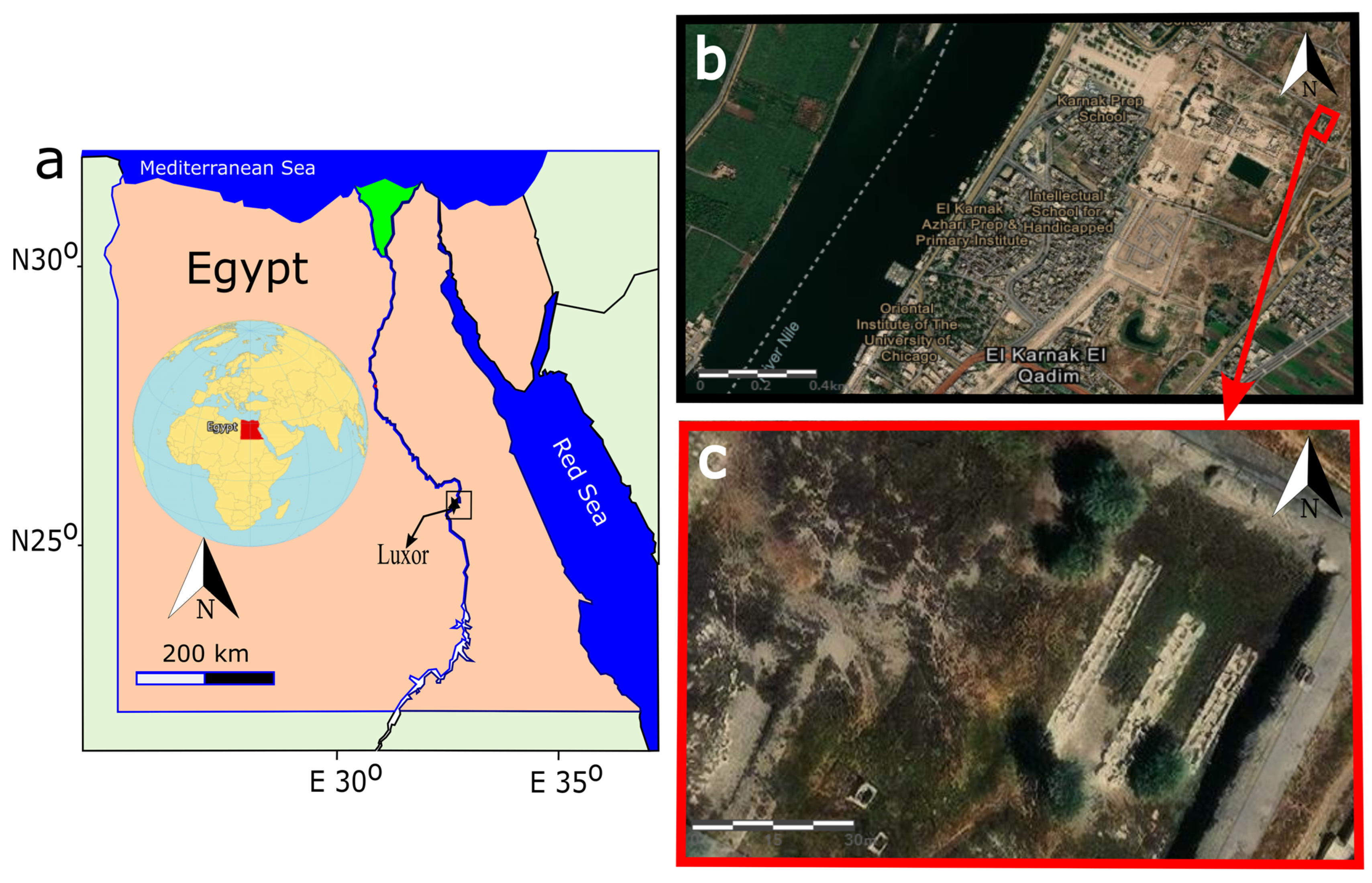
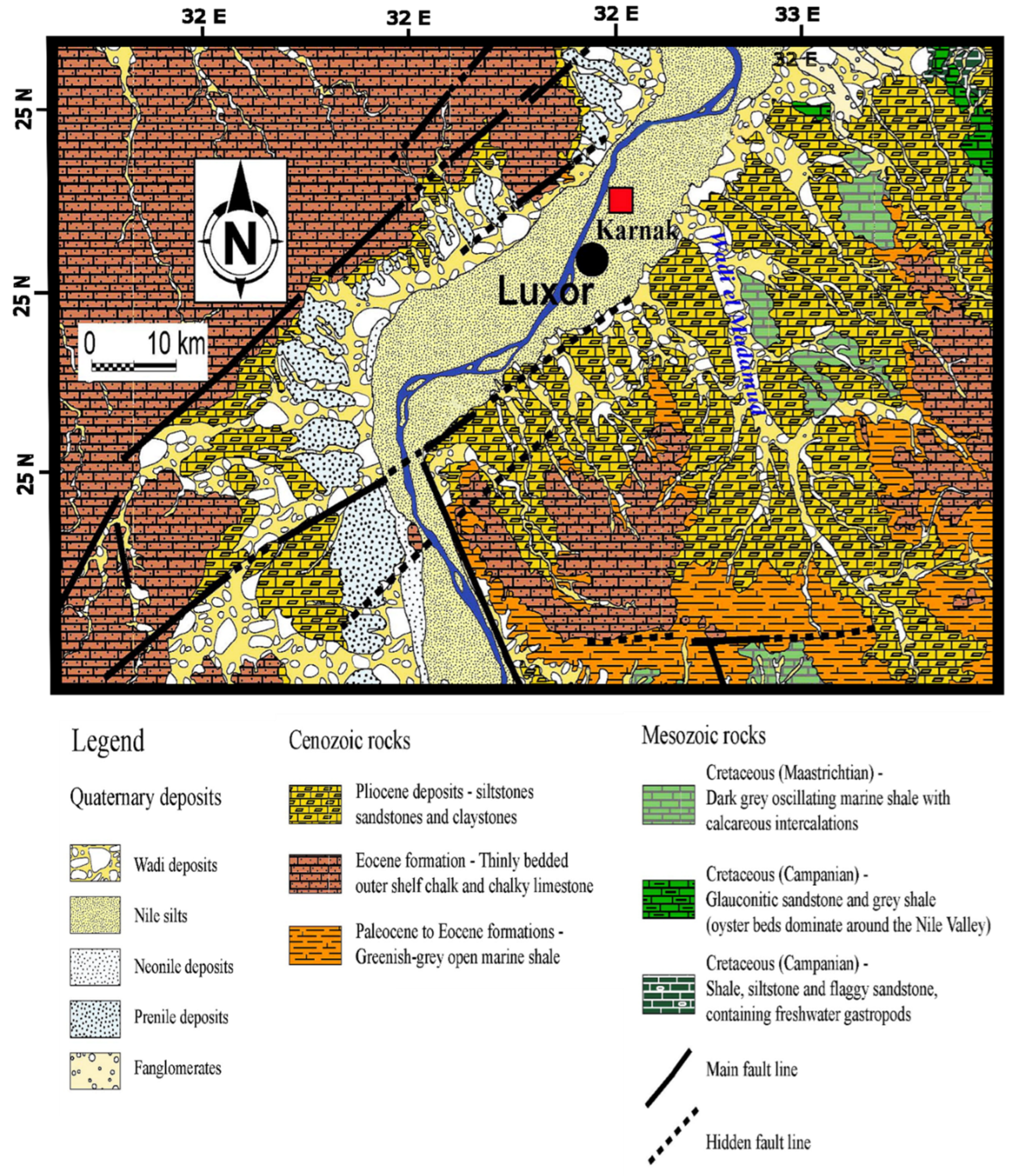
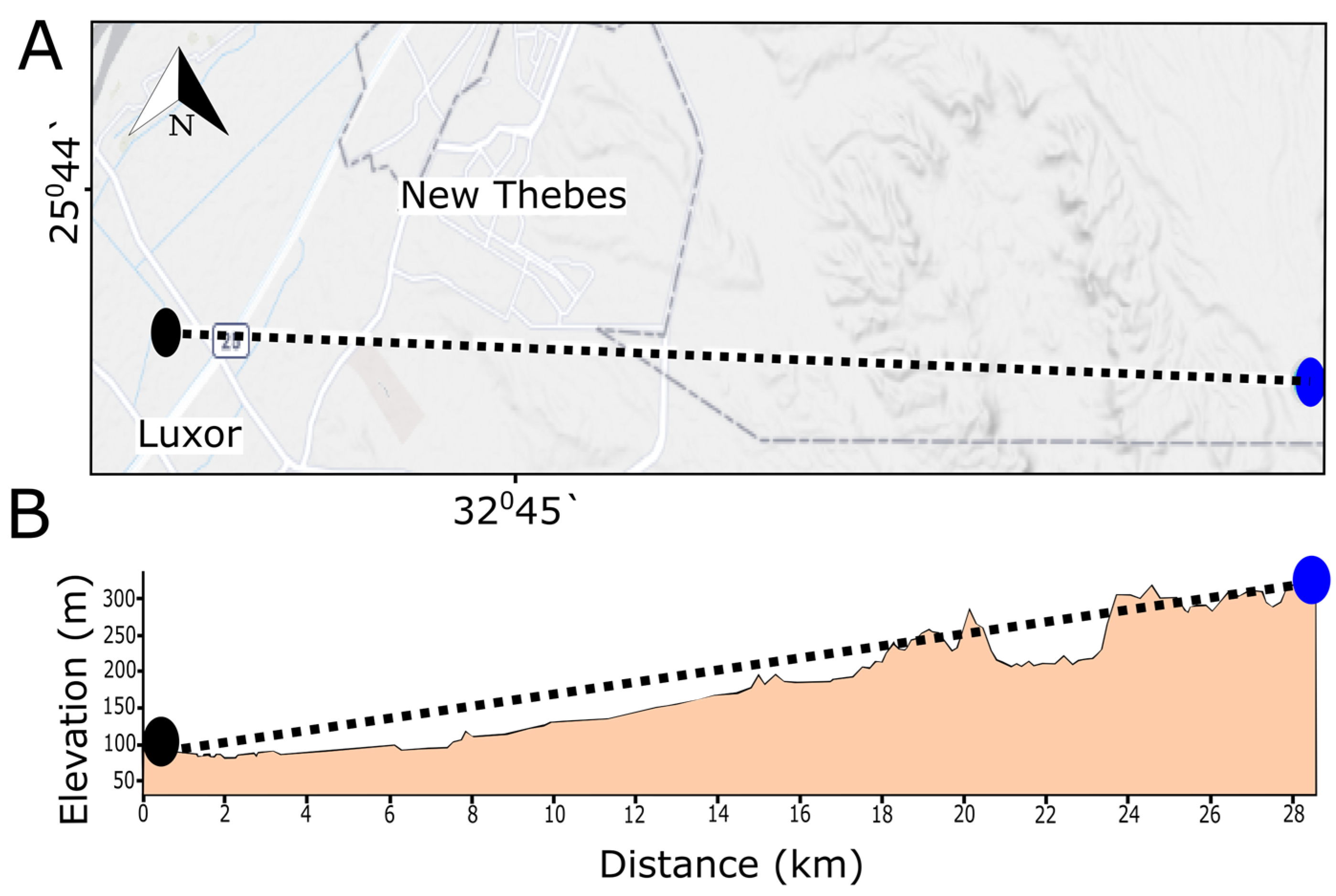
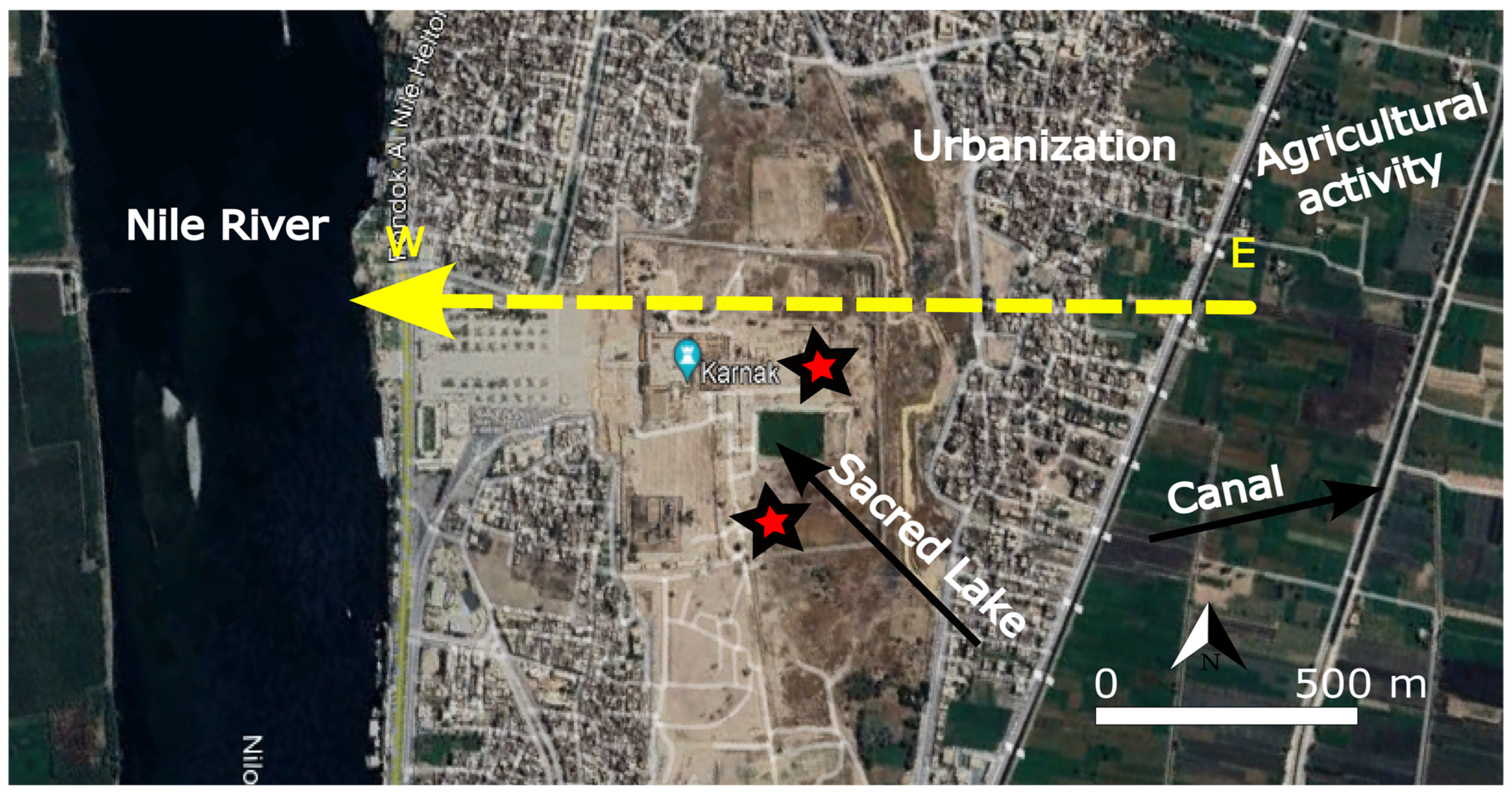



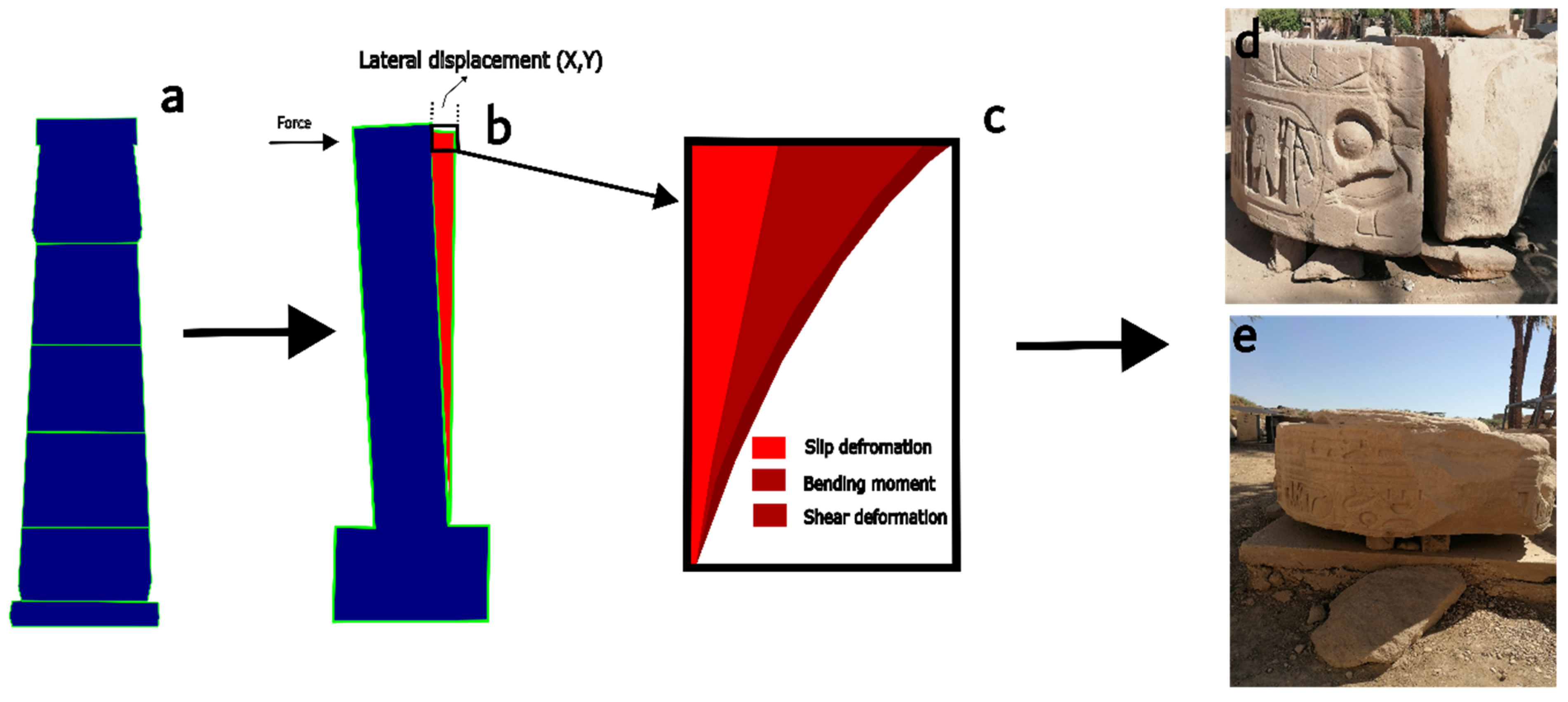

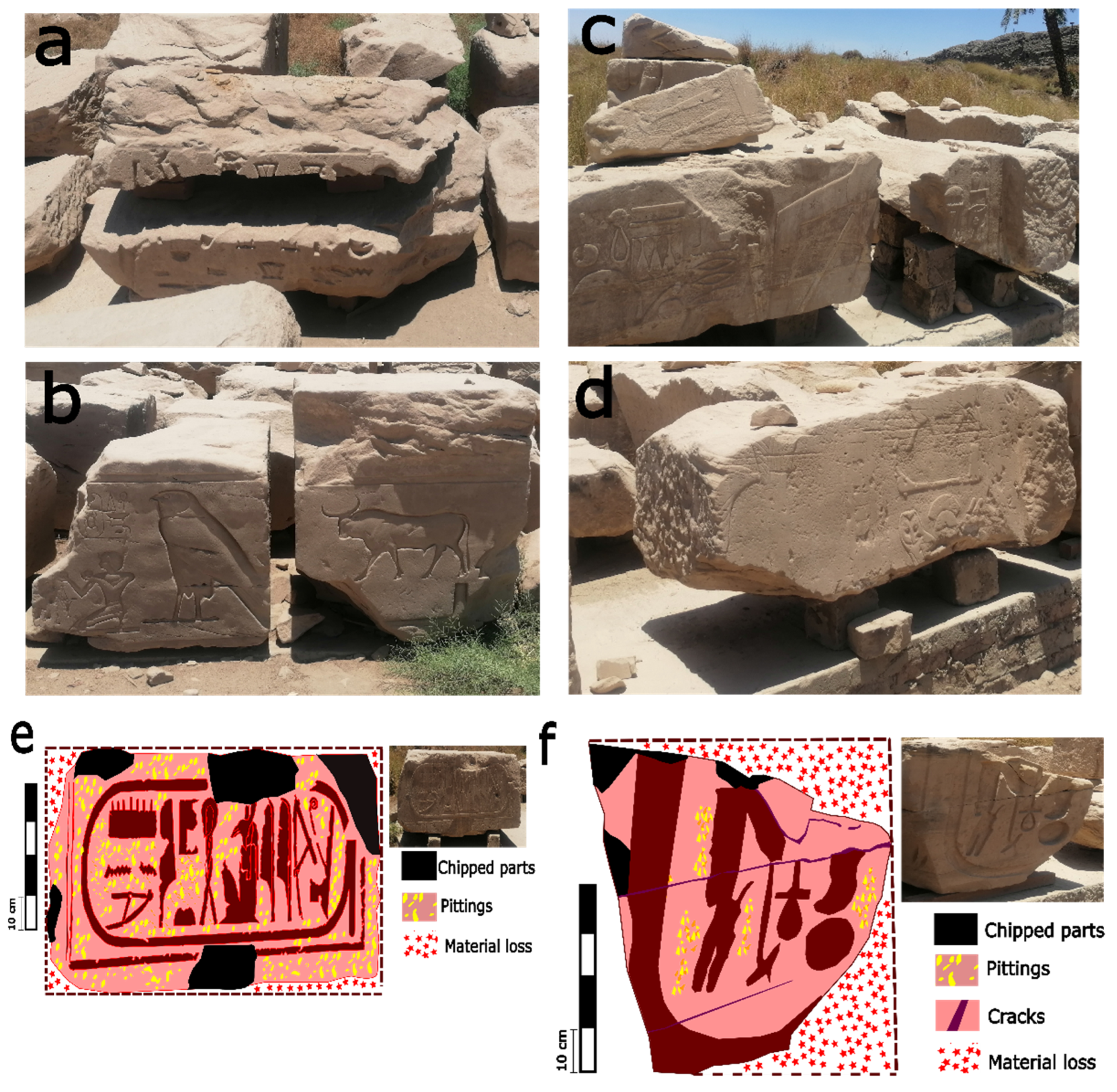

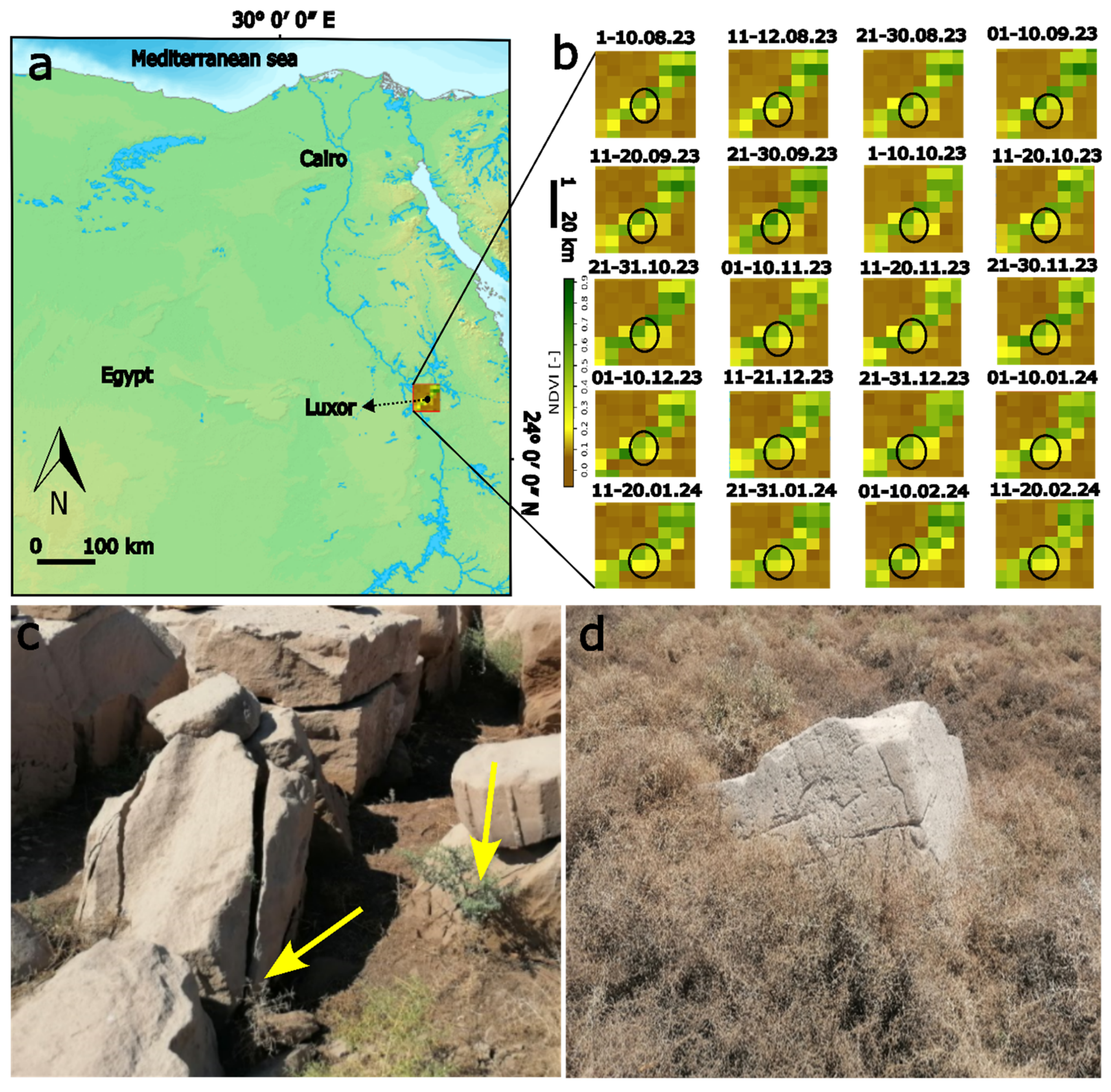

| Hydrological Context | Details |
|---|---|
| Main Water Sources | Nile River, canals, agricultural areas, drains, aquifers, urban waste. |
| Contamination Sources | Agriculture (irrigation), soil and structure dissolution, groundwater salinity. |
| Water Contaminants | Sodium (Na+), Potassium (K+), Sulfate (SO4−2), Chloride (Cl−1). |
| Salinity Levels | - Nile River: 173 mg/L - Canal: 280 mg/L - Drains: 426 mg/L - Sacred Lake: 780 mg/L - Groundwater beneath Karnak: 524–1363 mg/L. |
| Groundwater Aquifers | - Shallow Quaternary aquifer (5–95 m thickness) - Plio-Pleistocene aquifer (high salinity). |
| Water Movement and Impact | Groundwater flows from agricultural areas eastward toward the Nile River, increasing salinity levels beneath Karnak. |
| Rising Groundwater Issue | Periodic water level rise observed since the 1990s. Groundwater-Lowering Project (2007–2012) was conducted but water levels increased again in 2023. |
| Climate Context | Details |
| Summer Temperatures | Ranges from 39 to 44 °C (June–September), with very low humidity and almost no rainfall (1–2 mm). |
| Winter Temperatures | Ranges from 23 to 35 °C (November–April) with cooler nights having temperature drops of 5 °C. Slight rainfall of up to 4.2 mm in May and 0.0 mm in August. |
| Climate Projections (2100) | Temperature increases of 3–3.5 °C are expected. Rainfall decreases of −5% to 10% are expected. |
| Wind Conditions | Winds blow from the east. Daily wind speed ranges from 1 m/s to 5 m/s. March 2024 wind speeds: max 7.19 m/s, min 1.02 m/s. |
| Damage Type | Cause | Description | Effects on Structural Elements |
|---|---|---|---|
| Column Dismantling | Earthquakes and Flooding | Columns, especially at the bottom, were damaged due to lateral loads from seismic events and flooding pressures. | Structural instability, potential collapse, and dismantling of columns. Increased shear forces lead to low efficacy under lateral dynamic loads. |
| Stone Block Fracturing | Earthquakes | Stone blocks were fractured due to seismic waves transmitting through the ground, leading to sharp cracks and breakage. | Out-of-plane movements caused fractures in blocks, separating them into pieces, with partial or total failure. Vertical seismic waves caused rapid up-and-down shaking, worsening the damage. |
| Sharp Chippings | Earthquakes | Chipping with sharp edges formed during seismic events as a result of the forces applied on stone blocks. | Deformation of the stone surfaces. |
| Rounded/Peeled Chippings | Weathering | Rounded edges caused by weathering actions. | Gradual degradation of stone elements over time. |
| Cracking and Separation | Earthquakes and Ground Conditions | Cracking and separation occurred in stone blocks, forming fractures connected or unconnected across one or more blocks. | Stone blocks became separated and dislodged due to vertical seismic movement and unstable soil foundations. |
| Out-of-Plane Displacement | Earthquakes | The earthquake forces caused sections of walls to shift out of the plane. | Walls sustained severe damage, with deformation, dislodging, and partial collapse. |
| Soil Liquefaction | Earthquakes and High Groundwater Levels | Soil lost mechanical strength during earthquakes, causing liquefaction. | Structures sank, slid, or collapsed due to weak, liquefied soil. |
| Embedded Stone Blocks | Earthquakes and Weak Soil | Stone blocks became embedded in the clay soil due to ground subsidence and liquefaction. | Displacement and misalignment of structural blocks within the foundation soil. |
| Flooding Uplift and Displacement | Flooding | Hydrostatic forces during floods caused structural uplift and displacement. | Displacement, overturning, or uplift of entire sections of the temple during floods. |
| Flood-Induced Deformation | Flooding | Water pressure caused deformation, particularly in low-lying parts of structures. | Structural elements at the bottom were physically and chemically altered due to water exposure. |
| Block Overturning and Sliding | Earthquakes and Flooding | Stone blocks slid or overturned due to dynamic seismic forces or flood water. | Loss of structural integrity as blocks were displaced or completely overturned. |
| Soil Shrinkage and Swelling | Fluctuating Water Table | Soil changes in response to water level fluctuations caused shrinkage and swelling. | Contributed to the settlement of the structures, weakening the foundations and worsening structural damage over time. |
| Groundwater Table Fluctuations | Flooding | Increased water table and groundwater flow caused by floods or high surface water levels. | Damage due to changes in soil properties, such as settlement, swelling, and shrinkage. Structural foundations became unstable, leading to long-term deterioration. |
| Type of Damage/Decay | Cause | Description/Effect |
|---|---|---|
| Thermal (Stress/Load) | Temperature fluctuations | Microstructure decay (mineral cracking and fracturing), volumetric changes in quartz leading to microcracks, sugaring, flaking, and disintegration. |
| Mineralogical Decay | Composition of sandstone (quartz, albite, muscovite, etc.) | Sandstone with chlorite, biotite, dolomite, and kaolinite is less thermally stable. Clay minerals (e.g., kaolinite, illite) and phyllosilicates disintegrate at high temperatures. |
| Wind (Erosion/Abrasion) | Wind-driven sand and particles | Surface erosion, distortion of inscriptions, total polishing, rounding, scouring, pitting, flaking, and weakening of cementing particles. |
| Salt Weathering | Salts from contaminated water sources | Salt ions (NaCl, K2SO4) migrate through the soil and block the surface, leading to subefflorescence and efflorescence. Crystal growth in pores causes internal stresses and disintegration. |
| Capillary Action (Salt Creep) | Water movement through pores | Damage is caused through transportation, accumulation, solute concentration, precipitation, crystal fractionation, and the creeping of salts causing internal and surface damage. |
| Contaminated Water Infiltration | Water sources (urbanization, agriculture, canals, Nile, rain) | Waterborne contaminants lead to salt deposition, mechanical weakening, and breakage of the stone blocks. |
| Clay Swelling and Exfoliation | Presence of swelling clays (clinochlore, kaolinite) | Swelling of clay minerals in sandstone leads to inner defects, causing flaking and exfoliation, especially in the presence of water. |
| Month/Period | NDVI Range (Coverage) | Vegetation Coverage | NDVI Range (Density) | Vegetation Density |
|---|---|---|---|---|
| August 2023 (early) | Near 0 to 0.1 | Bare soil/sparse vegetation | 0.1–0.5 | Sparse vegetation |
| August 2023 (late) | 0.1–0.5 | Sparse vegetation | 0.5–0.6 | Moderately dense vegetation |
| September 2023 | 0.1–0.5 | Sparse vegetation | 0.5–0.6 | Increasingly dense vegetation |
| January 2024 (late) | Near 0 to 0.2 | Bare soil/sparse vegetation | 0.1–0.3 | Sparse vegetation |
| February 2024 (early) | 0.5–0.7 | Dense vegetation | 0.6 and up | Dense green vegetation |
Disclaimer/Publisher’s Note: The statements, opinions and data contained in all publications are solely those of the individual author(s) and contributor(s) and not of MDPI and/or the editor(s). MDPI and/or the editor(s) disclaim responsibility for any injury to people or property resulting from any ideas, methods, instructions or products referred to in the content. |
© 2024 by the authors. Licensee MDPI, Basel, Switzerland. This article is an open access article distributed under the terms and conditions of the Creative Commons Attribution (CC BY) license (https://creativecommons.org/licenses/by/4.0/).
Share and Cite
Fahmy, A.; Molina-Piernas, E.; Domínguez-Bella, S. Conservation Assessment of the Stone Blocks in the Northeast Corner of the Karnak Temples in Luxor, Egypt. Minerals 2024, 14, 890. https://doi.org/10.3390/min14090890
Fahmy A, Molina-Piernas E, Domínguez-Bella S. Conservation Assessment of the Stone Blocks in the Northeast Corner of the Karnak Temples in Luxor, Egypt. Minerals. 2024; 14(9):890. https://doi.org/10.3390/min14090890
Chicago/Turabian StyleFahmy, Abdelrhman, Eduardo Molina-Piernas, and Salvador Domínguez-Bella. 2024. "Conservation Assessment of the Stone Blocks in the Northeast Corner of the Karnak Temples in Luxor, Egypt" Minerals 14, no. 9: 890. https://doi.org/10.3390/min14090890
APA StyleFahmy, A., Molina-Piernas, E., & Domínguez-Bella, S. (2024). Conservation Assessment of the Stone Blocks in the Northeast Corner of the Karnak Temples in Luxor, Egypt. Minerals, 14(9), 890. https://doi.org/10.3390/min14090890









